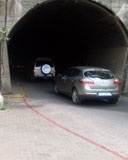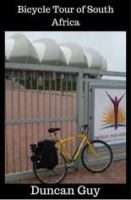
Photograph: Mellow Yellow at the Hartbeespoort Tunnel
I made an early start from the backpackers’ lodge, at first feeling the presence of the bushveld around me as thorn trees hugged the roadside. Once I was on the main, tar road, dodging cyclist-unfriendly traffic, the feeling of being in the bush fell away.
This was not because of any change in vegetation. It was only because a high wall ran for kilometres along the roadside, enclosing hectares of bush country that appeared to be earmarked for a secure housing estate that would offer residents a game-reserve feel.
There wasn’t a roadside tree, or bush, for shade, nor shelter along that roadside. There was just the road then a bare patch of ground and then this wall.
I related a lot to pedestrians while on my ride, especially when I wanted a comfort stop.
My first attempt to find a sheltered spot on the other side of the dam wall ended when I ventured up a pathway only to meet a baboon that had probably come down to the road in search of scraps.
Later, when I was more desperate, I was lucky enough to find a low bush, which I crept into like an animal. I was only just out of sight from the road.
I became curious about how little politicians and planners were conscious of the needs of pedestrians who, after all, are a good many of South Africa’s voters.
So far I’d given the route from Pretoria West to Atteridgeville full marks, and zero points to the people who plan and rule the area around Hartbeestpoort.
COMMENT: What do you think the government could do to make life easier for pedestrians?
****
The midday heat had set in when I reached the tunnel through which cars travel through a mountain before crossing the dam wall. I knew there would be home-made ginger beer waiting for me at Tan’ Malie se Winkel on the other side of the wall. Her shop is the capital of Boerekos food.
The waitress realised my needs and repeatedly filled up a big glass of the delicious brew. I weakened and allowed a Boerekos hamburger to follow. And melktert.
I postponed my departure from 1pm to 2pm. I’d have postponed it to 3pm were it not for the raindrops that began to cool the air.
Lightning streaked across the sky and thunder rumbled as angry clouds rolled towards me from the direction of Nooitgedacht, which a little more than a century ago would have heard gunfire during the Second Anglo-Boer War.
My destination for the night was Weaver’s Roost, a holiday resort close to Barton’s Folly, an old blockhouse from those days.
These blockhouses were watch towers that the British built all over the country, in which they placed guards who would look out for the Boers.
I had asked the manager at Tan’ Malie se Winkel how far away it would be.
“Fifteen minutes’ drive,” he replied.
That didn’t help. I wasn’t driving a car and at a rough estimate it took me a day to complete the distance a car would do in an hour.
So I asked some security guards who had finished their shift how far it was.
“Six kilometres,” they replied.
That turned out to be nonsense.
At a village called Skeerpoort a drunk man and his wife emerged from a tavern. He made motions towards mounting his bicycle but was just not steady enough on his feet.
“How far to Hekpoort (near Barton’s Folly)?” I asked him.
“Nine kilometres,” he replied.
Later, when looking at a map I confirmed that he was spot on.
Cyclists should trust fellow cyclists, I thought!
COMMENT: Have you ever found out that someone who may not appear reliable is in fact so?


